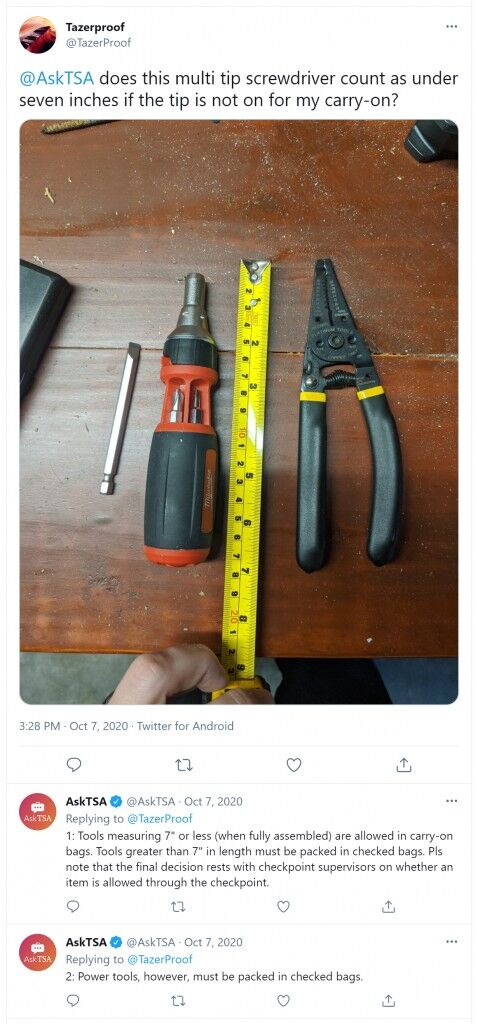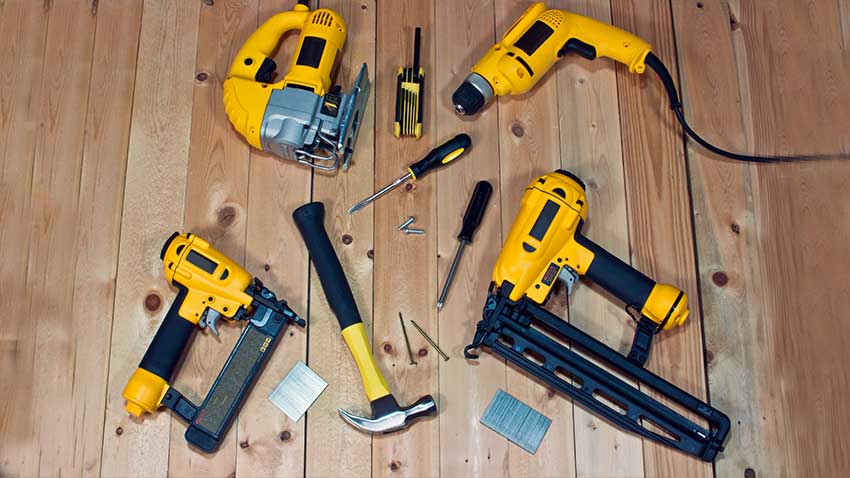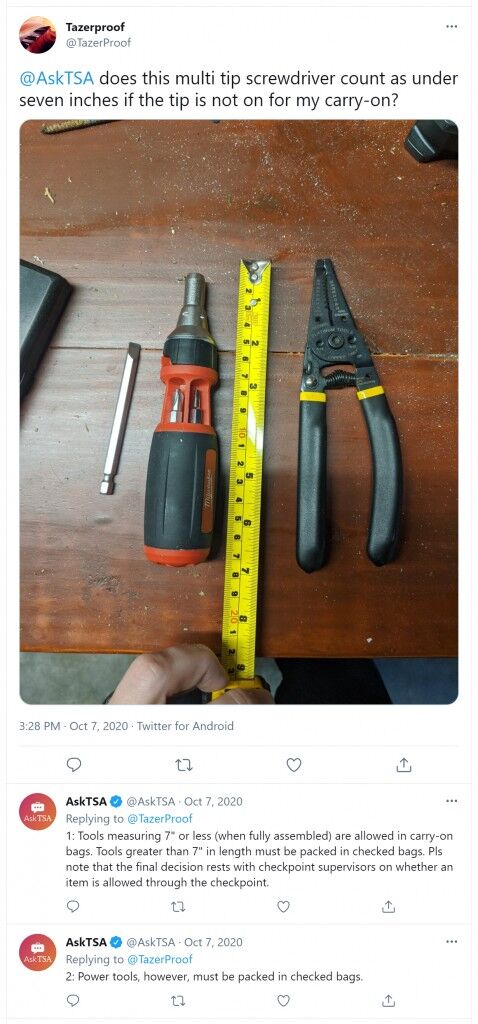Can you take power tools on an airplane? It’s a question that many DIY enthusiasts and travelers may have. Power tools can come in handy for various projects, whether you’re a professional contractor or enjoy DIY projects at home. However, when it comes to air travel, there are certain restrictions and regulations in place for the safety of passengers and crew. So, let’s find out what the rules say about taking power tools with you on an airplane.
When it comes to packing your bags for a flight, there are certain items that are restricted for safety reasons. Power tools, such as drills, saws, and nail guns, fall into this category. However, that doesn’t mean you can’t bring them on a plane at all. In fact, you may be allowed to bring them as checked baggage.
For most airlines, power tools are permitted in checked baggage as long as they are properly packed and meet certain criteria. It’s important to ensure that your power tools are securely packaged to prevent any damage or accidents during transit. Also, it’s a good idea to remove any sharp attachments or accessories that could pose a safety risk.
So, if you’re a DIY enthusiast or a professional tradesperson who needs to bring their power tools along for a trip, don’t worry! You can still take them with you on the plane, as long as they are packed safely and comply with the airline’s guidelines. Remember to check with your specific airline before traveling to ensure you’re aware of any additional requirements they may have. Now, let’s dive deeper into the details of taking power tools on an airplane.

Can You Take Power Tools on an Airplane?
Traveling by airplane with power tools can be a concern for many people, especially those who often use these tools for work or hobbies. The thought of having to leave behind valuable and necessary equipment can be worrisome. However, it is important to understand the regulations and guidelines set by airlines and transportation authorities to ensure safety for all passengers. In this article, we will explore the rules regarding traveling with power tools on an airplane, the restrictions imposed, and some tips to make the process smoother.
Rules and Regulations for Traveling with Power Tools
Before packing your power tools for your upcoming flight, it is crucial to familiarize yourself with the rules and regulations implemented by airlines and aviation authorities. Each airline might have slightly different policies, but there are general guidelines that apply across the board.
1. Check with the Airline
Prior to your travel date, contact your airline directly or visit their website to obtain specific information about their policy on carrying power tools. Some airlines may have restrictions on the type of power tools you can bring, the size and weight limitations, and whether they can be transported in carry-on or checked baggage. It is best to clarify these details in advance to avoid any unexpected surprises at the airport.
2. Research the Transportation Security Administration (TSA) Guidelines
The TSA is responsible for ensuring the safety and security of passengers in the United States. To comply with their regulations, be aware that certain power tools might be classified as either prohibited or restricted items. Prohibited items are strictly forbidden from being brought onto a plane, while restricted items may be allowed under certain conditions or if certain requirements are met.
3. Pack Properly
When packing your power tools, it is essential to follow certain guidelines to ensure their safe transportation. Here are some tips to consider:
- Remove any sharp or dangerous attachments from the power tools and pack them separately.
- Safely secure all cords and cables to prevent damage during transit.
- Wrap the power tools in protective material or use padded cases to prevent scratches or dings.
- Place the power tools in your checked luggage rather than carry-on to adhere to size and weight limitations.
- Consider emptying any fuel tanks or removing batteries to comply with airline regulations.
4. Declare Your Power Tools
When going through the security checkpoint at the airport, it is important to declare your power tools to the TSA officers. They may need to inspect the items, and it is best to be transparent to avoid any unnecessary delays or complications.
5. Additional Considerations
Some power tools may require specific documentation or permits for certain destinations. This is especially true for large or specialized tools. Before traveling, research the country’s rules and regulations regarding power tools to ensure smooth passage through customs.
Power Tools in Carry-On or Checked Bags
Now that we have explored the general rules and regulations, let’s take a closer look at whether power tools can be packed in carry-on bags or if they need to be checked.
Power Tools in Carry-On Bags
While the TSA allows certain tools in carry-on bags, power tools are generally not permitted. Power tools such as drills, nail guns, circular saws, and other items with sharp blades or high-powered motors are typically seen as potential security risks. Sharp tools can potentially be used as weapons, and the high-powered motors could potentially interfere with the aircraft’s electrical systems.
However, there are exceptions to this rule. Battery-powered tools with removable batteries may be allowed in carry-on bags if the battery is removed and placed in a separate bag. Additionally, smaller hand tools that do not pose a security risk, such as screwdrivers or pliers, are usually permitted in carry-on bags.
Power Tools in Checked Bags
Checked bags generally provide more flexibility when it comes to traveling with power tools. As long as the tools are properly packed, adhere to size and weight limitations, and do not contain any prohibited items, they can be transported in checked luggage.
However, it is important to note that airlines might have specific guidelines regarding the transportation of power tools in checked bags. Some airlines may require the tools to be packed inside a locked toolbox or sturdy case to prevent damage to other baggage or potential accidents during handling.
Benefits of Traveling with Power Tools
While there are certain restrictions and guidelines to follow when traveling with power tools, there are also benefits to being able to bring these tools along on your journey.
1. Convenience
Having access to your power tools during your trip can provide convenience and save you time and effort. If you are traveling for work or need to complete a project while away, having your own tools ensures that you are equipped with familiar and reliable equipment.
2. Cost Savings
Traveling with your power tools can also save you money. Renting or purchasing tools at your destination can be costly, especially if you require them for an extended period. Bringing your own tools eliminates the need for additional expenses.
3. Peace of Mind
For individuals who rely on their power tools for a living or are passionate about their hobbies, being able to bring their tools on an airplane provides peace of mind. Knowing that their tools are safe and accessible allows them to focus on other aspects of their trip without worrying about finding suitable replacements or dealing with unfamiliar tools.
Tips for Traveling with Power Tools
To make your experience of traveling with power tools more convenient and hassle-free, here are some additional tips to consider:
1. Do Your Research
Before packing your power tools, research the specific policies and requirements of the airline you will be flying with. Being well-informed allows you to pack accordingly and avoid any last-minute surprises or issues at the airport.
2. Plan Ahead
If you know you will need your power tools at your destination, plan your packing and make space for them in your luggage. Avoid overpacking to ensure there is enough room for your tools and any necessary accessories.
3. Consider Alternatives
If you are traveling for a short period or have limited luggage space, consider alternatives to taking your power tools. Look into renting tools at your destination or exploring the possibility of borrowing tools from colleagues or friends in your destination city.
4. Protect Your Tools
Invest in protective cases or bags to keep your tools safe during transport. This will help prevent any damage or scratches and prolong the lifespan of your equipment.
5. Take Inventory
Before and after your trip, take inventory of your power tools. Ensure that everything is in good working condition and that no items are missing. This will help you identify any potential issues or damage that may have occurred during travel.
All You Need To Know About Traveling with Power Tools
Traveling with power tools is indeed possible, but it requires careful planning and adherence to regulations set by airlines and transportation authorities. By familiarizing yourself with these rules, packing your tools properly, and being aware of the benefits and limitations, you can enjoy the convenience and peace of mind that comes with having your power tools on your journey. Remember to always check with your airline before traveling and follow any specific instructions or guidelines they provide. Happy travels!
Key Takeaways: Can You Take Power Tools on an Airplane?
- 1. Power tools are generally not allowed in carry-on baggage.
- 2. Power tools can be packed in checked baggage if they meet certain criteria.
- 3. Blades and sharp objects must be securely packed to prevent injuries.
- 4. Some power tools may be prohibited due to safety concerns.
- 5. It is recommended to check with the airline beforehand to ensure compliance with their specific regulations.
Frequently Asked Questions
When it comes to traveling with power tools, there are a few important things to consider. Below are some common questions people have about taking power tools on an airplane, along with their answers.
1. Are power tools allowed in carry-on luggage?
Yes, power tools are generally allowed in carry-on luggage. However, there are some restrictions and guidelines to follow. Make sure the tools are not classified as prohibited items and do not contain any sharp objects. Additionally, it’s important to check the airline’s regulations as some may have specific restrictions on the size or weight of power tools in carry-on luggage.
It’s also a good idea to pack the tools in a sturdy case or bag to prevent any damage or accidental activation during the flight. Be prepared to remove the tools from your bag during the security screening process for inspection.
2. Can power tools be packed in checked baggage?
Most power tools can be packed in checked baggage. However, it’s important to carefully pack them to ensure they are secure and do not pose a risk to baggage handlers. Remove any sharp or hazardous parts and place the tools in a durable case or wrap them in protective material to prevent damage.
Some high-powered or larger tools may require special handling or additional documentation. It’s always a good idea to check with the airline beforehand to understand their specific requirements and any restrictions they may have.
3. Are there any specific guidelines for lithium-ion battery-powered tools?
Yes, there are guidelines for traveling with lithium-ion battery-powered tools. These tools are typically allowed in carry-on and checked baggage, but there are restrictions on the capacity of the batteries. Spare lithium-ion batteries with a capacity of more than 100 watt-hours are generally not allowed in checked baggage, but they can be packed in carry-on luggage.
It’s important to keep the batteries properly packaged to prevent accidental activation. Many airlines require the batteries to be placed in their original packaging or in individual protective cases. Always check with the airline for their specific guidelines on traveling with lithium-ion battery-powered tools.
4. Are there any specific regulations for international travel?
Yes, when traveling internationally with power tools, it’s important to be aware of the regulations of both your departure and arrival countries. Different countries may have their own rules and restrictions on carrying power tools, both in carry-on and checked baggage.
It’s advisable to research the specific guidelines of the countries you will be traveling to and ensure compliance with their regulations. It’s also a good idea to contact the airline for any additional requirements or documentation needed for international travel with power tools.
5. Are there any tools that are not allowed on an airplane?
Yes, there are certain tools that are not allowed on an airplane. These include tools with sharp or pointy edges, such as knives, machetes, and swords. Flammable tools or those that contain explosive materials are also prohibited.
Additionally, tools that can be used as weapons, such as hammers, crowbars, and drill bits longer than 7 inches, are not allowed in carry-on baggage. However, they may be packed in checked baggage if properly secured and declared to the airline. It’s important to review the Transportation Security Administration (TSA) guidelines for a comprehensive list of prohibited tools.

Summary
So, can you take power tools on an airplane? Well, it depends on the type of tool. Generally, small handheld tools like screwdrivers and wrenches are allowed in carry-on luggage. However, larger power tools with sharp or hazardous parts are typically not allowed and must be checked in. It’s always a good idea to check with the airline beforehand to make sure you’re following the rules and regulations. Remember, safety and security are the top priorities when it comes to air travel, so it’s important to be aware of what you can and cannot bring with you on the plane.
